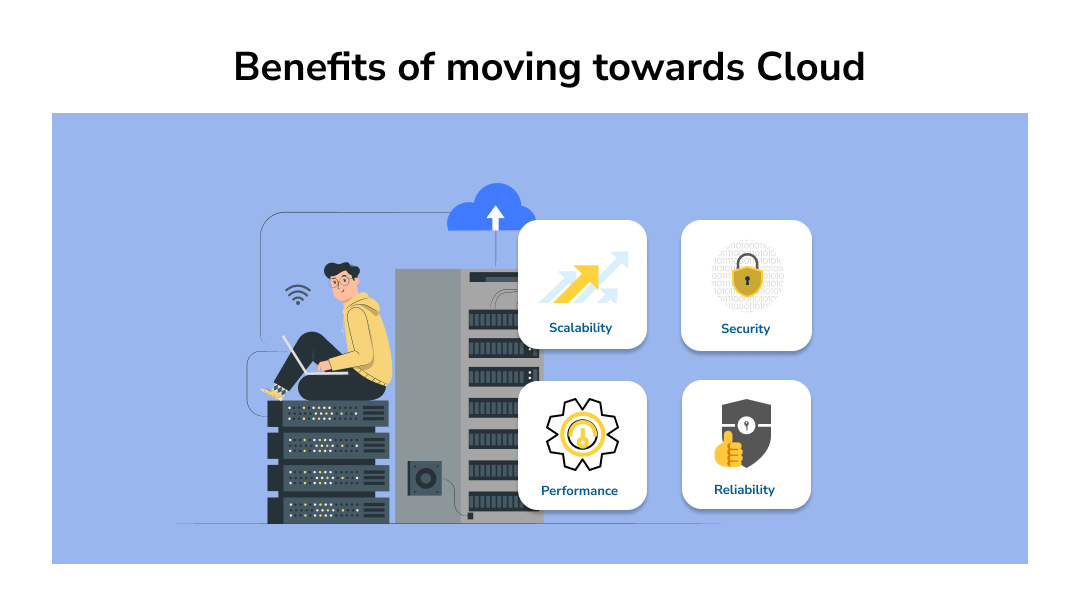Cloud Application Development: Born as a Boon
Looking back to the 1990s, every growing business was struggling to manage the on-premise infrastructure and had to worry about so many things like,
Will there be room for expansion as the business grows?
How to maintain 100% uptime?
Can cable connectivity be established without compromising on performance?
How to manage hardware replacements without any production impact?
And the list goes on...
So, there was a purpose and that’s when Cloud Technology was born as a boon to us, hence bringing in the three giants - Amazon Web Services (AWS), Microsoft Azure & Google Cloud Platform to make our lives hassle-free.
Now let’s fast forward to the era of Cloud Computing.

What is Cloud Application Development?
Cloud application development refers to building, testing, deploying and running software services in the cloud. Apps developed using cloud services are called Cloud Apps.
Cloud Application Development involves huge amounts of data getting processed through third-party-owned IT infrastructure; the only thing the users would need is a laptop or desktop that is connected to the Internet. When a user interacts with a web or mobile app, a user request is processed by the remote server and a response is given back to the user. To make it simpler, we daily use many cloud-based apps such as Google Drive, Figma, LinkedIn, Twitter, Google Maps etc. These apps allow users to connect on a real-time basis, and also provide an interface to collaborate from anywhere across the globe.
Benefits of Cloud App Development
- Cost Saving: Pay only for what you use, with no IT procurement or maintenance costs
- Operational Flexibility: Functions with fluctuating bandwidths efficiently
- Enhanced Risk Management: Cloud services providers employ high-tech methodologies to keep resources up-to-date
- Scalability: Scale up or scale down your resources based on requirements anytime
- Improved Security: Robust systems, built using advanced technology have made Cloud Computing more secure and reliable than traditional on-premise solutions.

How to Develop a Cloud App?
When you got to know the numerous benefits of the cloud, why could you not go for it...
Yay!! Here are your baby steps to Cloud Development
- Market Research
- Architectural Functionality
- Scalable & Secure Systems
- Design & Develop
- Test & Launch
- Market Research
The very first step to kickstart your cloud journey would be getting to know more about the market trends.
- It involves analysis of the app and its user base, what’re the current pain points and how cloud technology can help in resolving them.
- Choosing the right Cloud Service Provider is crucial in this phase. You can conduct Surveys and Questionnaires to gather insights from Marketers, Competitors & End-users.
- Interpreting your findings & doing a SWOT analysis (Strengths, Weaknesses, Opportunities and Threats) can drive you towards a conclusive decision.
- Architectural Functionality
This phase involves architecting the infrastructure for your app. There are 3 different cloud types – Private, Public & Hybrid along with 3 Cloud Deployment Models – SaaS, PaaS, and IaaS. You can stick on to the service model that meets the business needs.
- App Components: A cloud app operates as a collection of interconnected services. You should know the right components to support integration with each other.
- Data Organization: Know where and how to store your data. Decouple app components & data to make the application most flexible.
- Communication Logic: Establish a communication logic between the services & data. Optimize the communication chain by using most components that can interact instantly with other services.
- Scalable & Secure Systems
Planning things in business will reap its benefits anytime. It’s wiser to think on a growing scale and anticipate potential problems. This phase will involve enhancing the Performance & Security of the app.
- In terms of Scaling, you can consider developing Stateless Applications as it allows processes, services and microservices to operate independently with few dependencies, making it easier to scale up granularly.
- Unresponsiveness or app crash is a major concern reported as the application scales. Using the Asynchronous Communication technique helps the application to remain responsive even as the volume of requests grows rapidly.
- Using Read Replicas in the database can bring down the heavy load in the primary instance, thereby enhancing Usability.
- When it comes to Security, Encryption at transit and rest is the first and foremost thing.
- Maximize security by granting the least Privilege. Strong Authentication and Access Control policies can keep you safe.
- Design systems to meet PCI or HIPAA guidelines.
- Keep the Servers and Software up-to-date to prevent vulnerabilities.
- Design & Develop
- UI/UX process: Designers prepare a user interface that helps end-user to interact with the system.
- Once Wireframes are ready, the development team starts coding the app’s functionality, implementing its front-end and back-end logic.
- Test & Launch
- It is mandatory to test the application if it works as expected and meets the desired User Experience. Based on the testing results, bug fixes or usability enhancement can be done if any.
- Deploy a Minimum Viable Product (MVP) into the market and run tests.
- Gather user feedback, improvise in the next cycle and launch again!
Conclusion
Cloud has not only resolved the issue of great data storage, but it has helped in carrying out all offline activities with sheer ease and swiftness via the internet. All you need to have is an internet connection and you are sorted. Cloud application development has made app development not just seamless but also opened doors for a plethora of new technologies. Now whether it is about architecting the functionality of your app, making your system secure and reliable or testing and launching, the cloud is the modern answer for all these tasks. This virtual world is the backbone of almost every organization and human being now.



